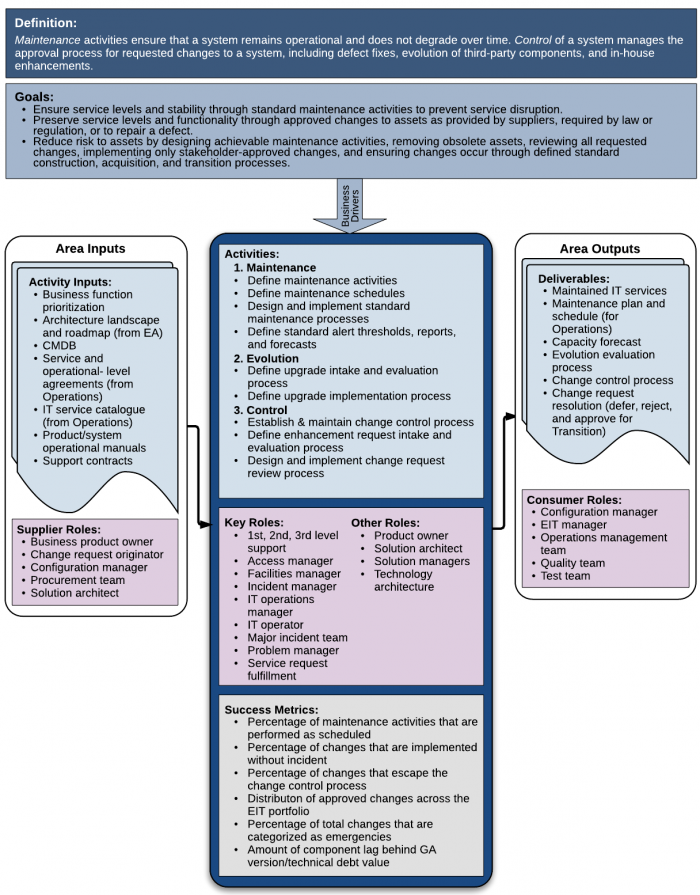Maintenance and Control
Contents
1 Key Competence Frameworks
While many large companies have defined their own sets of skills for purposes of talent management (to recruit, retain, and further develop the highest quality staff members that they can find, afford and hire), the advancement of EIT professionalism will require common definitions of EIT skills that can be used not just across enterprises, but also across countries. We have selected 3 major sources of skill definitions. While none of them is used universally, they provide a good cross-section of options.
Creating mappings between these frameworks and our chapters is challenging, because they come from different perspectives and have different goals. There is rarely a 100% correspondence between the frameworks and our chapters, and, despite careful consideration some subjectivity was used to create the mappings. Please take that in consideration as you review them.
1.1 Skills Framework for the Information Age
The Skills Framework for the Information Age (SFIA) has defined nearly 100 skills. SFIA describes 7 levels of competency which can be applied to each skill. Not all skills, however, cover all seven levels. Some reach only partially up the seven step ladder. Others are based on mastering foundational skills, and start at the fourth or fifth level of competency. It is used in nearly 200 countries, from Britain to South Africa, South America, to the Pacific Rim, to the United States. (http://www.sfia-online.org)
SFIA skills have not yet been defined for the this chapter.
1.2 European Competency Framework
The European Union’s European e-Competence Framework (e-CF) has 40 competences and is used by a large number of companies, qualification providers and others in public and private sectors across the EU. It uses five levels of competence proficiency (e-1 to e-5). No competence is subject to all five levels.
The e-CF is published and legally owned by CEN, the European Committee for Standardization, and its National Member Bodies (www.cen.eu). Its creation and maintenance has been co-financed and politically supported by the European Commission, in particular, DG (Directorate General) Enterprise and Industry, with contributions from the EU ICT multi-stakeholder community, to support competitiveness, innovation, and job creation in European industry. The Commission works on a number of initiatives to boost ICT skills in the workforce. Version 1.0 to 3.0 were published as CEN Workshop Agreements (CWA). The e-CF 3.0 CWA 16234-1 was published as an official European Norm (EN), EN 16234-1. For complete information, please see http://www.ecompetences.eu.
1.3 i Competency Dictionary
The Information Technology Promotion Agency (IPA) of Japan has developed the i Competency Dictionary (iCD), translated it into English, and describes it at https://www.ipa.go.jp/english/humandev/icd.html. It is an extensive skills and tasks database, used in Japan and southeast Asian countries. It establishes a taxonomy of tasks and the skills required to perform the tasks. The IPA is also responsible for the Information Technology Engineers Examination (ITEE), which has grown into one of the largest scale national examinations in Japan, with approximately 600,000 applicants each year.
The iCD consists of a Task Dictionary and a Skill Dictionary. Skills for a specific task are identified via a “Task x Skill” table. (Please see Appendix A for the task layer and skill layer structures.) EITBOK activities in each chapter require several tasks in the Task Dictionary.
The table below shows a sample task from iCD Task Dictionary Layer 2 (with Layer 1 in parentheses) that correspond to activities in this chapter. It also shows the Layer 2 (Skill Classification), Layer 3 (Skill Item), and Layer 4 (knowledge item from the IPA Body of Knowledge) prerequisite skills associated with the sample task, as identified by the Task x Skill Table of the iCD Skill Dictionary. The complete iCD Task Dictionary (Layer 1-4) and Skill Dictionary (Layer 1-4) can be obtained by returning the request form provided at http://www.ipa.go.jp/english/humandev/icd.html.
The information is not available yet.
